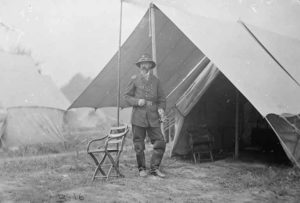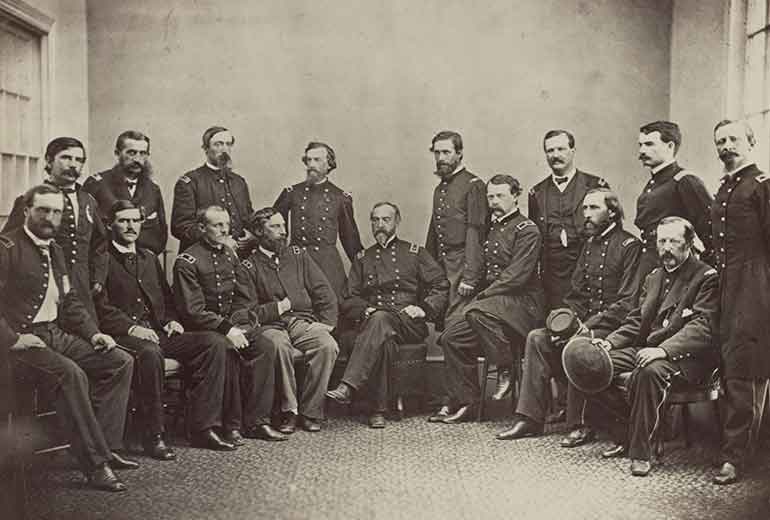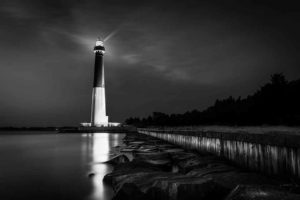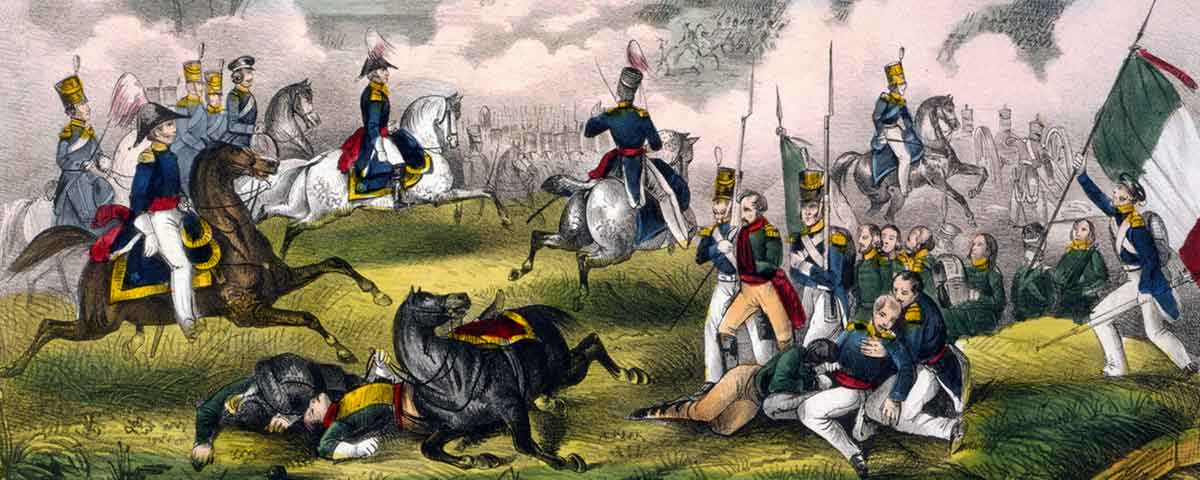Two Roads Taken: George Meade found fame as Both a Warrior and an Engineer
[dropcap]“W[/dropcap]hat a waste of time and energy,” George Meade wrote to his wife on December 18, 1845, as he approached his 30th birthday. Describing his feelings about his 10 years in the U.S. Army since graduating from West Point, Meade was convinced he was a failure and added, “I tremble sometimes when I think of what I might have been, and remember what I am, when I reflect on what I might have accomplished.”
A few days later, Meade received a letter from his mother that confirmed his feelings of remorse and failure. “Although in my ignorance, I was cruel enough to send you to West Point, an act for which I shall never forgive myself, and never cease to regret, I did not dream that you would enter the army, my dear George.”
But it was too late for regrets. As far as Meade was concerned, his life was already ruined.
[quote style=”boxed” float=”left”]George Gordon Meade never wanted to be a soldier.[/quote]
He had no childhood dreams of glory on the field of battle, no tradition of military service to carry on, no family heroes to emulate. For several generations up to that time, the Meades had been a wealthy, well-connected Philadelphia family. George’s father dishonored the family by being sent to prison for fraud, losing most of his fortune and dying young, leaving his wife and family with few resources. George had no interest in attending the U.S. Military Academy, but his mother insisted that he do so because there was no other future available to him. Ever the dutiful son, he had gone off to West Point.
George, the family’s eighth child of 11, was born in Cadiz, Spain, where his father, Richard Worsam Meade, had been established as a trader, ship owner, and agent for the U.S. Navy. Richard Meade added immensely to the family fortune. In Cadiz, they lived lavishly in a house of great opulence that held one of the nation’s finest art collections. Original works by Titian, Correggio, Rubens, and Van Dyke decorated the walls, along with portraits of members of the Meade family by the famous American painters Gilbert Stuart and Thomas Sully. Also there was a large portrait by Stuart of George Washington (without his false teeth).

But then it all fell apart. Richard Meade was charged with financial improprieties and imprisoned in Spain for two years. After his release, he remained there to try to recoup his losses and settle his legal problems while his wife, Margaret, took the children back to Philadelphia. There, with little money to their name, their lifestyle was described as “genteel poverty.”
George was 12 in 1828 when his father died. Despite the family’s financial problems, the boy was enrolled in a boarding school in Baltimore that was modeled after the U.S. Military Academy. “He was considered an amiable boy,” his son wrote years later, “full of life, but rather disposed to avoid the rough-and-tumble frolics of youths of his age; quick at his lessons; and popular with both teachers and scholars.”
Although Meade wanted to study law, his mother insisted he go to West Point, as tuition was free and not enough money was available for a private college. West Point was also considered suitable for a young gentleman at his level of society. George agreed to enroll, but insisted that he was not going to become a soldier. He vowed to leave the Army after completing his year of required active duty service following graduation. Young Meade believed he was too ambitious to settle for routine army life in a series of small isolated posts with low pay, slow promotions, and boring duties. Perhaps inspired by his father’s one-time success, he wanted more than what he thought the Army could offer.
[dropcap]M[/dropcap]eade entered West Point when he was 15, and it was a measure of the level of society of which the Meades were still a part that President Andrew Jackson appointed him. Fellow students remembered George as dignified and courteous, “with the air of the highest breeding.” He was an indifferent student from the beginning, however, and the longer he stayed at the Military Academy, the less motivated he was to do well.
Meade was also a careless, indifferent cadet, not bothering to maintain his uniform and equipment to the required standards. His shoes and belt buckles were never the brightest or shiniest of the bunch. He was not a model student on the drill field either, and by his third year had accumulated 168 demerits—perilously close to the 200 that would lead to immediate expulsion, no matter how well-connected one’s family might be.
[quote style=”boxed” float=”left”]Meade’s baptism by fire came at Palo alto during the Mexican War. He later Conceded he had ‘No Stomach’ for fighting.[/quote]
But Meade did graduate, 19th of 56 in the Class of 1835. Every new graduate was entitled to a three-month leave before beginning his active-duty service. Meade spent his sabbatical working as a surveyor for the Long Island Rail Road, hoping to gain practical experience and to make useful contacts in the booming railroad business.
In January 1836, Meade joined his regiment at Fort Brooke, near Tampa, Fla. The outfit was engaged in the Second Seminole War. He lasted only four months in that semitropical climate before becoming ill, perhaps with malaria, and being declared physically unfit for duty in the field. The frail soldier’s next assignment was in Watertown, Mass., which, although cooler, did not please him either.
And so Meade resigned from the Army in October 1836, and began working as a surveyor on a series of private contracts that took him back to Florida, Texas, along the Mississippi River, and into the far Northwestern territories. Between each job he returned to Washington, where his mother then lived, to court Margaretta Sergeant, daughter of the wealthy congressman John Sergeant from Philadelphia. Meade married Margaretta on December 30, 1840.
[dropcap]M[/dropcap]eade continued with the same kind of short-term contract work, unable to secure a more permanent job. His prospects became even bleaker when the U.S. Army decided to end all private contracting with civilians for surveying and mapping. Instead, all such work would be performed by the Army’s own Corps of Topographical Engineers, which had been established in 1838. To find work, Meade would have to go back into the Army. But it was not easy to get a commission, even for a West Point graduate, so he had to turn to Governor Henry Wise of Virginia, who had married Margaretta’s sister, to make it happen.
Meade’s first duty assignment was building lighthouses along the Delaware coast. For the first time in his married life, he lived in his own home with his wife and children. The family was happy until this stable existence was threatened when Meade was ordered to report to Texas, where the Army faced the threat of war with Mexico. Just as Meade had not wanted to be a soldier, so he did not want to go to war. But he had no choice. It was then, in December of 1845, that Meade wrote to his wife just before his 30th birthday, lamenting what he saw as his life of failure.
[quote style=”boxed” float=”left”]It is unlikely Meade ever realized his wife had used her government contacts to influence his swift promotion within the Union Army.[/quote]
Meade, a reluctant soldier at best, quickly learned that he did not like field duty with its privations, marches, poor food, heat, and other hardships. His baptism by fire came at Palo Alto, the first major battle of the Mexican War (near what is now Brownsville, Texas). Meade’s outfit came under artillery fire and he witnessed the bodies of dead and wounded soldiers up close. Meade seemed proud of how well he had done, describing in a letter to his wife “the pleasant excitement of victory,” and adding: “It will make you happy I know to hear of so brilliant an affair, and of your good husband having had a share in it.”
A few weeks later, however, after more combat, Meade’s enthusiasm dampened. He wrote: “Such is war and its terrible consequences. For my part, I have no hesitation in saying I have no stomach for it. I trust I shall always do my duty…but I candidly acknowledge I have no penchant for it; nothing but a sense of duty would keep me at it.”
Although Meade did remark on the grace and beauty of Mexican women, his litany of complaints continued, including his objection to the use of volunteer soldiers (instead of Regular Army troops) who were streaming into Mexico from the United States to join the fight. He called them an “armed rabble,” and said they were often drunk and disorderly, and more trouble than they were worth. Meade railed against the press for what he called “newspaper notoriety,” which gave more credit to some than to others. He was probably responding to his wife’s comment that she never saw mention of his name in the lists of promotions in the Washington, D.C., newspapers. Why was George still a second lieutenant when so many of his classmates, and even younger officers, were promoted to higher ranks?
Meade said he felt no disappointment at not being promoted because he had not expected to be. “I was fully prepared for my not being noticed.” He added that he could claim no personal distinction in the two battles in which his unit had fought because he was a staff officer, which gave him few opportunities for heroic actions that could bring promotion and glory.
Meade also suggested to his wife that he did not have the political influence in Washington that led to publicity and promotions. That was a strange grievance to claim for a man whose in-laws were so well-connected. He decried “the mighty engine of political influence, that curse of our country.”
[dropcap]A[/dropcap]fter the war, Meade returned to his duties of surveying coastlines and building lighthouses in Florida, Delaware Bay, New Jersey, and the Great Lakes area, spending little time with his family. Finally, when Meade was 35 years old, some 16 years after his graduation from West Point, he was promoted to first lieutenant; five years later, he was promoted to captain.
Yet Meade’s career looked less promising than ever, and his depression grew. The only future he saw was a repeat of his past. But then came war; it was 1861. George Meade was stationed in Detroit for the Great Lakes Survey and he resolved not to spend another war in the Topographical Corps but to have an active combat command, with a rank more fitting to his age. Meade wrote to the War Department asking for a new command, but received no reply. He tried several times more without success and so he went to Washington in person.
After all, Meade insisted, he was a West Point graduate and a veteran of the Mexican War. Surely the country needed trained and capable men to lead the new armies that would have to be formed to meet the Confederate threat. Meade knew most of the other officers who were obtaining promotions and important commands, but no one at the War Department paid any attention to his requests for an active leadership role. He returned to Detroit, fearing that he was going to miss his one last chance to find fulfillment and accomplishment after his years of dedicated service.
Then, on August 31, 1861, more than four months after the war began, Meade was advanced four ranks to brigadier general and given command of a volunteer brigade from his family’s home state of Pennsylvania. He may not have ever known that his wife had arranged for his sudden promotion through her contacts with influential members of the government. There is no record of Meade’s asking her to intercede on his behalf.
[quote style=”boxed” float=”left”]Meade was flattered to Hear he was under consideration as the Army of the Potomac’s New Commander. He also believed he had no chance of being chosen.[/quote]
This was his first time commanding troops, and Meade was determined to be successful. Over the next two years, he served under every commander of the Army of the Potomac and fought in significant battles at Mechanicsville, Second Bull Run, Antietam, Fredericksburg, and Chancellorsville, among others. Meade earned a reputation as a dependable and solid, if not particularly brilliant, leader of men. His troops, wary of his short temper, fought well for him, though they called him “the old snapping turtle.” By November 1862, he wore the two stars of a major general.
[dropcap]Y[/dropcap]et through all the battles, praise in the newspapers, and the promotion, Meade griped in letters to his wife about how other officers had advantages because of their political connections. “In our army, an officer has to run the chances of having his political friends in power…A poor devil like myself, with little merit and no friends, has to stand aside and see others go ahead.”
The Army of the Potomac, commanded at the time by bombastic Maj. Gen. Joseph Hooker, suffered another major defeat at the Battle of Chancellorsville, which ended on May 6, 1863. Clearly the Union’s principal army needed a new leader, and rumors began to circulate that Meade was being considered for the job, an idea supported by some of his fellow officers. When Meade heard the rumors he was flattered, but he believed he had no chance because of his professed lack of political influence. On May 10, he wrote to Margaretta: “I do not believe there is the slightest probability of my being placed in command…[H]aving no political influence…it is hardly probable that I shall be called on to accept or decline.”
More than a month later, with the question of leadership still unresolved, Meade wrote that he did not “stand any chance [of being chosen] because I have no friends, political or other, who press or advance my claims or pretensions, and there are so many others who are pressed by influential politicians that it is folly to think that I stand any chance upon mere merit alone.” He then added a curious, self-effacing comment: “It remains to be seen whether I have the capacity to handle successfully a large army.”
On June 28, after Robert E. Lee’s Army of Northern Virginia had crossed the Potomac River and was driving north into Union territory, Meade was awakened in his tent at 3 a.m. by Colonel James Hardie, sent as a special courier from Washington. Hardie, an old friend, contrived to make a joke. He told Meade that he had bad news—Meade was being relieved of his duties as a corps commander.
Meade reportedly said he was not surprised; he had been expecting it. Then Hardie told him the good news, that Meade had been appointed commander of the Army of the Potomac.

At first Meade protested, claiming that he was not prepared or capable of leading the Union’s largest army. He said he would telegraph the War Department immediately asking that his orders be rescinded and the position given to some other officer. Hardie reminded Meade that he had no choice. He could not turn down the offer: He was the best person available to deal with Lee’s invasion of Pennsylvania.
Meade reluctantly agreed. “I’ve been tried and condemned without a hearing, and I suppose I shall have to go to the execution.” In a letter home to his wife, Meade wrote: “You know how reluctant we both have been to see me placed in this position, and as it appears to be God’s will for some good purpose. At any rate as a soldier I had nothing to do but accept… I am moving at once against Lee.”
Five days later, on July 3, in a little-known town called Gettysburg, George Meade, who had never wanted to be a soldier, led his army to victory. On July 8, he wrote to his wife: “I think I have lived as much in this time as in the last thirty years.”
Duane Schultz is the author of numerous articles and books on military history, including The Dahlgren Affair: Terror and Conspiracy in the Civil War; The Most Glorious Fourth: Vicksburg and Gettysburg; and The Fate of War: Fredericksburg, 1862.
Eternal legacy

In his book Searching for George Gordon Meade: The Forgotten Victor of Gettysburg (Stackpole Books, 2013), historian Tom Huntington reminds us that George Meade spent more time building lighthouses and conducting surveys than he did at war. That never seemed to bother the general, evident by his reaction to a “quickie” popular biography published shortly after the Battle of Gettysburg “to capitalize on his fame.” Meade was disappointed at how little attention the biography dedicated to his antebellum engineering successes. “I always thought my services in the construction of lighthouses, and subsequently on the [Great] Lakes Survey, were of considerable importance,” Meade lamented, according to Huntington.
The 163-foot-tall Barnegat Lighthouse, on the coast of New Jersey’s Long Beach Island, remains perhaps Meade’s most notable engineering accomplishment. By no means is it his only one. Others include Brandywine Shoal Lighthouse in Delaware Bay, Cape May Light and Absecon Light in New Jersey, and Sand Key Light and Carysfort Reef Light in Florida. At 171 feet, the Absecon lighthouse is actually taller than Barnegat and is the third tallest such structure in the United States.
As Eric Jay Dolin notes in his book Brilliant Beacons: A History of the American Lighthouse (Liveright, 2016), Meade was the first U.S. engineer to adopt the new so-called screw-pile approach in constructing lighthouses upon unstable ocean beds—in which “multiple iron pilings tipped with spiral flanges up to three feet across were corkscrewed into the ocean floor to hold the lighthouse structure.” The technique was used to erect the lights at Brandywine Shoals, Carysfort Reef, and Sand Key.
Meade was also the first American engineer to adopt the French Fresnel lens, which at the time shone a more powerful light than any other yet invented. “This marvelous contrivance darts forth its dazzling flash,” Meade wrote at the time, “and revolving as it flashes, only intermits its light still more to startle the beholder.” –D.S.





